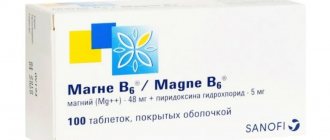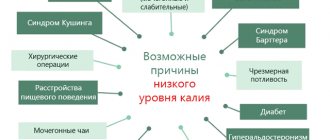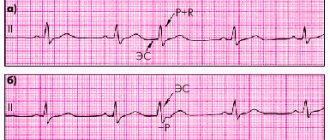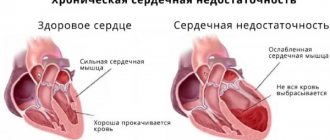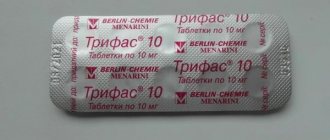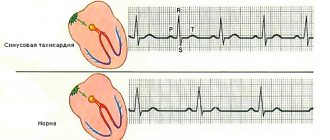Medicines based on ions of inorganic compounds are used for diseases of the heart, blood vessels, central nervous system, and a number of other pathological processes.
The use of such medications without a doctor’s prescription poses a tremendous danger to the health and life of the patient. Therefore, unauthorized use is impossible and creates a risk of death.
Potassium preparations are medications that contain compounds of the same element in various forms: salts, etc. In medical practice, tablets are used, as well as solutions for intravenous infusion.
The choice of a specific type depends on the situation. If an urgent and powerful effect is needed, preference is given to the solution, and in other cases to tablets.
There are many indications for the use of potassium-containing medications: mainly deficiency heart diseases, accompanied by a decrease in myocardial contractility, surges in blood pressure and arrhythmias. Uncontrolled use creates a threat of death.
All questions regarding the fundamental possibility of using medications, as well as patterns of use, are resolved by a cardiologist during an in-person examination. And strictly after at least basic diagnostics.
Why do we need potassium supplements?
Medicines containing potassium play a huge role in the treatment of cardiovascular pathologies. This is mainly due to the ability to cover the need for electrolytes, restore normal balance, stabilize blood pressure, etc. These effects are possible due to the beneficial effects of ions.
Potassium is an electrolyte. It is involved in a whole group of processes that are directly related to the condition of the heart, blood vessels, and central nervous system (partially).
Among the beneficial effects of normal concentrations of this element:
- Reduced blood pressure. The mechanism of influence here is complex. In short, the tone of the sympathetic nervous system is normalized. Which leads to normalization of the condition of the arteries. Relief of spasms, elimination of excess tension on the part of blood vessels. In addition, tissue sensitivity to insulin increases, and cardiac output increases, to normal levels for this particular patient.
- The substance is able to adjust the rhythm of the muscle organ. This effect is due to the normalization of pumping function and restoration of contractility of the muscle layer.
- Potassium itself can accelerate metabolic processes in the myocardium. Which is vital, for example, in case of heart failure. In a system with certain active substances in a number of drugs, the electrolyte enhances the metabolic effect. Such complex medications can be used as part of the treatment of cardiac dysfunction, after a heart attack and in other emergency conditions.
Potassium is mainly found in bound form. 98% is located in cells, only the remaining two percent circulate in the bloodstream.
The substance actively interacts with other electrolytes. Magnesium ensures normal absorption of ions.
Sodium (table salt) acts as their antagonist: with an increase in its concentration, excessive excretion of potassium is observed and vice versa.
In addition, the element provokes an increase in blood pressure and instability of the muscular organ, but one cannot do without it, since sodium substances help regulate the tone of the heart and blood vessels.
Physiological action
Along with calcium, phosphorus, sodium, chlorine, it is the main vital macronutrient for us. Depending on gender and age, our tissues contain from 150 to 250 g, which is approximately 0.35% of the total body weight.
Among other macroelements, potassium ranks third in content in the body, second only to calcium and phosphorus.
The physiological role is largely due to the contradiction, antagonism with another electrolyte, sodium (Na). Both macronutrients, sodium and potassium, are similar in many ways. Both are alkali metals, both are reactive. But their content inside the cell and in the extracellular space is not the same. Most sodium is found on the outside of the cell. There is 14 times more of it here than inside the cell.
For potassium, everything is exactly the opposite. This is an intracellular macroelement, and there is 35 times more of it inside the cell than outside. Of course, such a difference or gradient of sodium and potassium ions on both sides of the cell membrane cannot be created by itself.
There must be some mechanism that operates at the subcellular level and maintains the transmembrane gradient of K and Na.
And there is such a mechanism. This is the so-called sodium-potassium pump or pump. In this case, the pump refers to a specific transport enzyme, sodium-potassium ATPase. The essence of the work of this enzyme is to transport sodium ions out of the cell, and potassium from the outside into the cell, against the gradient.
This process is called active transport. It differs from passive transport, in which the movement of electrolytes occurs on its own, along a gradient, as a result of which the content of ions on both sides of the membrane is equalized.
Active transport is a complex, energy-dependent process and occurs in several stages:
- Sodium ions concentrate inside the cell near the membrane, and in the same way potassium ions concentrate outside the cell.
- ATPase is phosphorylated and cleaves off the phosphoric acid residue from the Adenosine Triphosphate (ATP) molecule.
- In the phosphorylated state, the enzyme captures 3 sodium ions and moves them outward.
- From the outside, sodium-potassium ATPase captures 2 potassium ions.
- Next, dephosphorylation of the enzyme sodium-potassium ATPase occurs.
- In the dephosphorylated state, it moves potassium ions into the cell.
Ultimately, during each cycle, 3 sodium ions move out of the cell, and instead, 2 potassium ions move into the cell.
The importance of the sodium-potassium pump cannot be overestimated.
- Due to the fact that instead of 3 positively charged sodium ions, only 2 positively charged potassium ions enter inside, the inner part of the membrane becomes more negatively charged in relation to its outer side. The membrane is polarized, and an electrical potential difference is formed on both sides of the cell. This value is called the transmembrane potential. This value reflects the electrical activity of the cell.
- The permeability of the membrane to sodium and potassium ions is not constant and can change. Accordingly, the polarization of the membrane changes in one direction or another (depolarization, repolarization, hyperpolarization). The mechanism of changes in transmembrane potential in various parts of cell membranes underlies the occurrence and conduction of impulses along nerve fibers. After all, nerve impulses from a physical point of view are nothing more than weak currents. And these currents are formed by potassium and sodium.
- It is an integral part of buffer systems. These are biochemical mechanisms whose work is aimed at maintaining the acid-base balance inside the cell and in the extracellular space at a constant level.
- Sodium maintains osmotic or concentration pressure and carries water with it. Thus, due to the activity of the sodium-potassium pump, water circulates between the cell and the extracellular space. Together with water, the waste products of the cell are removed outside, and everything necessary comes in - glucose, amino acids, fatty acids, and other electrolytes.
- Potassium ions are part of many intracellular enzyme systems. These systems provide the synthesis of proteins, glycogen, fatty acids, and other biologically active compounds.
Thus, thanks to the sodium-potassium pump, cellular metabolism (metabolism) is carried out, the electrical activity of the cell is formed, and the state of the intracellular environment is maintained at a constant level (homeostasis). This process is continuous. And since it is carried out artificially, against the gradient, energy is required.
Each cycle with the transport of 2 K ions and 3 Na ions is provided by the energy generated by the breakdown of 1 ATP molecule. And on the scale of the entire organism, up to a third of the energy consumed is used to ensure this process. But this energy is renewed when glucose is utilized in the Krebs cycle, when new ATP molecules are synthesized. And here, too, potassium cannot be avoided.
Once the sodium-potassium mechanism fails, the concentration of sodium and potassium on both sides of the cell membrane is equalized. The transmembrane potential disappears, intracellular metabolic processes stop. Water accumulates inside the cell along with sodium. All this leads to cell death.
All intracellular effects of the macroelement have a positive effect on the function of organ systems.
- The cardiovascular system
It is called the heart element, and for good reason. It ensures the correct distribution of nerve impulses along the conduction system of the heart, regulates the automaticity, excitability and conductivity of the myocardium. In addition, it saturates myocardial cells with energy. Thanks to this, the heart contracts with a force sufficient to circulate blood through the vessels.
Thus, K prevents heart failure and heart rhythm disorders.
In addition, it regulates the tone of blood vessels and normalizes blood pressure (BP). Thanks to it, blood delivery to the myocardium through the coronary (heart) vessels is improved. Thus, K prevents ischemia (insufficient blood flow) to the myocardium and its hypoxia (oxygen deficiency).
- Nervous system
Thanks to the transmembrane transport of potassium, impulses are generated in sensory, motor and autonomic nerve fibers. In addition, it is known that it is involved in the formation of acetylcholine, a neurotransmitter that ensures the transmission of impulses through synapses, contacts between the bodies of neurons and their processes (axons).
Along with other vitamins and minerals, K forms the mental and emotional-volitional sphere: improves memory, intellectual abilities, eliminates negative emotions, normalizes sleep. In addition, its action improves blood circulation through the cerebral (cerebral) vessels. This macroelement reduces the likelihood of cerebral ischemia and stroke.
- Musculoskeletal system
Thanks to it and acetylcholine, impulses are transmitted from nerve fibers to muscles. In addition, it stimulates energy production in muscle tissue, increases muscle strength and endurance. It also strengthens bone tissue and prevents the development of osteoporosis.
The increase in bone strength is largely due to the fact that it promotes the deposition of another macronutrient, calcium, in bone tissue.
- Digestive system
Triggers peristalsis (wave-like contractions of smooth muscles) of the gastrointestinal tract. In addition, it regulates the secretion of gastric juice, duodenal juice and pancreas. It also relaxes the sphincters (muscle valves) of the gallbladder and biliary tract, and promotes the discharge of bile.
It also prevents the formation of stones in the gall bladder and bile ducts.
- urinary system
Regulates the excretion of sodium by the kidneys, and with it water. Thus, it helps to increase diuresis (volume of urine excreted). Stimulation of diuresis, in turn, leads to the elimination of edema and a decrease in blood pressure. In addition, the mineral prevents stone formation in the urinary tract.
Other effects include normalization of body weight. It has been established that this macronutrient promotes the utilization of glucose and prevents the development of diabetes and obesity. In addition, along with other factors, it strengthens the immune system, and thereby increases the body’s resistance to infectious diseases.
In what cases does it make sense to prescribe them?
The main indication is potassium deficiency in the body (hypokalemia). It is not difficult to detect the problem: it is enough to conduct a biochemical blood test with an expanded picture of electrolytes.
- Previous myocardial infarction. A dangerous emergency condition associated with the death of tissue in the muscular layer of an organ against the background of a critical lack of nutrition and breathing. Accompanied by severe cardiac dysfunction, which is difficult to correct outside the hospital.
Potassium is necessary to reduce the heart's need for oxygen, stabilize metabolic processes, and restore blood pressure levels.
The rehabilitation process after a heart attack is described in this article. Primary and secondary prevention - here.
- The need to correct potassium deficiency during treatment with certain drugs. These include cardiac glycosides, bronchodilators, such as Berodual. Also glucocorticoids. Dexamethasone, Prednisolone and many others, diuretics, thiazide or loop series. There are plenty of options. What they have in common is the ability to excrete potassium quickly and in large quantities. Therefore, it is necessary to replenish the supply from the outside.
- Chronic heart failure. Accompanied by a gradual increase in myocardial dysfunction. Contractility decreases. Recovery is possible through complex therapy. Total cure cannot be achieved, but compensation is quite possible. Which has a positive effect on the prognosis. Potassium supplements ensure normal metabolism, lower blood pressure and prevent the risks of further progression of the condition.
- Coronary heart disease and angina pectoris. Precursors to a full-blown infarction. The essence is the same, only there is no mass death of the tissues of the muscular layer of the organ yet.
- Arrhythmias of different types. In addition to those associated with disruption of the functioning of the conduction system. For such indications, the medication should be used with great caution.
- Arterial hypertension, regardless of stage. As a supportive measure. Potassium-containing drugs are prescribed as a mild means for correcting blood pressure levels. However, in isolated form the effect will be minimal.
When are potassium supplements ineffective and why?
Despite the list of indications, potassium-containing drugs are not always quite effective.
Why is that?
The problem is the cause of the drop in the level of the substance in the blood. Many clinical situations are related to human behavior, poor lifestyle, or third-party diseases.
Therefore, it makes sense to first carefully examine the patient, eliminate the root cause, and only then prescribe a course of potassium medications.
In what cases and why is this electrolyte removed:
- Nutritional factor. A person does not consume enough foods that are based on minerals. In particular potassium and magnesium. This is perhaps the most likely reason.
- Long-term use of diuretics, also bronchodilators and other drugs that can remove electrolyte ions. In such a case, the main treatment option is to avoid medications that harm the heart. But this is not always possible, then adjustment of the treatment regimen and dosage, or the prescription of another drug is required.
- Consuming a lot of sodium. As was said, it is a potassium antagonist. The higher the concentration of one, the lower the level of the other. Both elements mainly come from food. The main measure to increase the effectiveness of treatment is diet correction.
- Malabsorption in the intestine. The reason for this may be Crohn's disease, frequent colitis and other disorders. They are subject to treatment.
- Pregnancy, peak hormonal states. At this time, there is an increased consumption of potassium. The mother's body needs substances from them as building materials for the formation of the child's body. Multiple pregnancies are especially dangerous in this regard.
Only after solving all the problems, weighing the pros and cons, can you begin treatment. Medicines containing potassium are by no means harmless.
Foods rich in potassium
Potassium is well absorbed from foods and is easily absorbed in the intestines.
However, a large amount of it is excreted in the urine. Therefore, the human body needs this element in large doses and every day. In summer, it is best to replenish potassium reserves with fresh fruits, vegetables and herbs, and in the cold season, dried fruits and nuts will cope with this task.
https://www.youtube.com/watch?v=ytcreatorsen-GB
Potassium is found in high concentrations in foods of plant origin. The highest potassium content is found in the following foods:
- dried apricots (1720 mg);
- beans (1100 mg);
- seaweed (1000 mg);
- peas (870 mg);
- prunes (860 mg);
- raisins (860 mg);
- almonds (750 mg);
- hazelnuts (720 mg);
- lentils (675 mg);
- peanuts (660 mg);
- pine nuts (630 mg);
- mustard (610 mg);
- potatoes (565 mg);
- cashew nuts (550 mg);
- walnut (500 mg).
The element is also found in white beans, cabbage, spinach, dates, sweet potatoes, melon, kiwi, avocado, bananas, pomelo, liver, milk, nut butter, chocolate, grapes and citrus fruits and any vegetables and herbs. A lot of potassium is contained in any dairy products and fish (fish contains about 200 mg of potassium per 100 g of product). Cereals are also rich in potassium (primarily oatmeal and millet).
There is a folk and very common method of replenishing the body with potassium. To prepare such a remedy, you need to take a small amount of honey and pour it with the same amount of vinegar. You should drink the resulting mixture no more than three times a day. The mixture is often used for salad dressing.
It is worth considering that products of plant origin, although rich in potassium, tend to remove large doses of sodium from the body. Animal products do not have this function.
At the same time, it is not enough just to consume foods rich in potassium - it is also important to prepare them correctly. During the process of soaking and cooking, potassium goes into the water, and if you do not use the broth in cooking, then potassium is lost.
The metal is better absorbed together with vitamin B6, and alcohol slows down its absorption.
List of drugs in tablets
They make up the majority on pharmacy shelves.
Kalinor
Potassium tablets (effervescent) contain citrate and carbonate (salts) of the named element.
It has an equally wide range of pharmaceutical activity, but is mainly prescribed as a highly specialized medicine. To correct electrolyte levels, as well as against the background of arrhythmias. As a medicine to restore normal heart function.
It is relatively safe, can be used in long courses, breaks in use are at the discretion of the treating specialist.
Potassium orotate
The list of potassium preparations for the heart includes Potassium Orotate. However, it differs from other forms of release. In addition to the standard action, it also has anabolic potential. Simply put, it significantly accelerates metabolic processes throughout the body.
This may be useful, for example, in cases of congestion in cardiac structures, heart failure, or a previous heart attack. The issue of necessity and expediency of use is decided at the discretion of doctors.
In addition, potassium orotate provides a pronounced regenerative effect. That is, it helps restore the integrity of tissues and organs. This is especially important in case of cardiosclerosis and emergency conditions.
The medicine is not safe:
- In addition to standard side effects such as dyspepsia, there is an intensification of kidney function. In the absence of diseases of the excretory system, this reduces the load on the heart. But in the presence of pathologies it can be extremely dangerous.
- Potassium orotate also reduces the absorption of iron and some antibiotics. Therefore, it is not recommended to take it during anemia or infectious diseases.
Otherwise, this is a powerful tablet form of the drug.
Potassium-normine
Chloride electrolyte compound. As the name suggests. It makes sense to use it only in extreme cases. Because the medication has a pronounced effect and often provokes side effects.
The appointment is made strictly according to the diagnostic results.
Attention:
Use in parallel with potassium-sparing diuretics is strictly prohibited. This is deadly.
Calyposis
An identical remedy, but the duration of its effect is longer. This is a prolonged form.
A potassium-containing drug in the form of tablets is prescribed if a milder effect is needed, there is no need to strictly check the dosage or titrate the drug.
The main disadvantage is the need for absorption in the digestive tract. In addition, the likelihood of developing stomach problems is higher due to the effect of the components of the products on the mucous membranes.
Properties
Potassium is a representative of group I of period IV of the periodic table of elements, where it is listed at No. 19. Atomic mass K is 39. One unpaired electron rotates in its outer orbit. Therefore it is monovalent, K(I).
Along with other metals of group I, incl. sodium, lithium, cesium, it belongs to the group of alkali metals. When interacting with other non-metallic substances, alkali metals easily give up their unpaired electron to them.
Therefore they are strong reducing agents. As the name suggests, these metals are capable of forming strong bases, alkalis.
Externally, it is a silver-white, lightweight and fusible metal. It is lighter than water - its density is 0.856 g/cm3. Already at a temperature of 63.550C, potassium melts and boils at a temperature of 7600C. It is not only light, but also soft metal - it can even be cut with a knife. True, it is not found in nature in its pure form.
In its atoms, the outer unpaired electron is relatively distant from the atomic nucleus and easily transfers to atoms of other substances. Hence its higher chemical activity in comparison with other alkali metals, lithium and sodium. The macroelement quickly oxidizes in air. When interacting with atmospheric oxygen, an oxide, K2O, a peroxide, K2O2, and a superoxide, СО2 are formed.
To protect pure potassium from oxidation, it is stored under a layer of oil or kerosene, liquids that do not allow oxygen to pass through. When interacting with water, caustic potash, KOH, and a very strong alkali are formed.
It reacts with all non-metals, with acids, as well as with salts of other metals.
In this case, potassium salts are formed. These salts are included in many natural minerals. Potassium-containing minerals are found in the soil and dissolved in the water of seas and lakes.
In terms of prevalence in the earth's crust, among all elements of the periodic table, potassium is in 7th place, and among all metals - in 5th place. Its percentage in the earth's crust is 2.5%.
In dissolved form, potassium penetrates from the soil into plant tissues, where, along with other factors, it provides photosynthesis. Then it enters the body of animals and humans as feed and food.
Injectable drugs
Potassium chloride in ampoules for intravenous administration. Similar to Potassium-normine, the only difference is in the release form. Used as an emergency remedy if a person has lost electrolytes too quickly.
For example, against the background of diarrhea, severe vomiting, dehydration, polyuria (excessive urination) as a result of diseases of the endocrine system, hormonal imbalance, and abuse of glycosides.
Allows you to quickly restore the ion concentration. But it is used with caution due to the high risk of side effects.
The choice between tablet and injection form falls on the shoulders of the doctor. The key criterion is the urgency of the required medication.
Preparations containing potassium and magnesium
Asparkam
A complex product available in tablet and liquid form, solution for injection. In addition to potassium, it also contains magnesium.
It has a higher concentration of active ingredients per unit compared to the analogue presented below (Panangin).
- Used as part of complex treatment of pathologies of the cardiovascular system.
- It is actively used for correction during a heart attack, since it can reduce the intensity of tissue death, narrow and localize the affected area.
- Helps with arterial hypertension, heart failure.
In addition to its therapeutic potential, it is used as a prophylactic agent. Because it has the ability to cover the needs for potassium and magnesium even without adjusting the diet.
But you need to drink Asparkam with great caution. Especially if the patient is taking potassium-sparing diuretics. Because an overdose is possible.
The concentration is selected by the treating specialist strictly after a thorough diagnosis. During use, constant monitoring of potassium concentration in the body is required. If there is such a need, the dosage of the drug is reviewed, and its complete withdrawal is possible.
Since potassium is excreted by the kidneys, it cannot be used for diseases of the excretory system. The same applies to allergic reactions, severe blockade of the conductive structures of the heart.
Side effects are usually minor if taken correctly. In some cases, problems with the digestive tract occur: nausea, vomiting, diarrhea, heartburn and others. Allergic disorders are also possible.
In general, this is an ideal drug for systematic therapy. Read a detailed description of what helps and when Asparkam is prescribed here.
Panangin
It is based on the same combination of potassium and magnesium compounds. However, the concentration per tablet is lower than in Asparkam.
Otherwise, there are no differences in terms of effectiveness, harm, side effects and other characteristics. It is possible to use one or another name. Depends on the indications.
Orocamage
Another product containing orotates. Contains potassium and magnesium. Mainly prescribed for complex forms of arrhythmia. Like extrasystole. Also for the treatment of coronary heart disease.
Causes and signs of deficiency
To a large extent, sodium excess predisposes to K deficiency. These macroelements can figuratively be called relatives-enemies. Both are from the alkali metal family, but both compete with each other for absorption in the body. The more sodium is absorbed, or reabsorbed by the kidneys, the more potassium is excreted through the kidneys.
At the same time, it has little effect on the excretion of sodium by the kidneys. This inequality is based on certain evolutionary prerequisites.
Our distant ancestors ate food containing potassium. And there was quite a lot of such plant food. At the same time, ancient people were practically unfamiliar with table salt. It is noteworthy that until recently, the aborigines living in remote corners of Africa and Latin America also did not consume salt for the simple reason of its absence.
But sodium is also the most important macronutrient for us. So the body has developed a complex regulatory mechanism called the RAAS, the renin-angiotensin-aldosterone system. This system works so that sodium is not excreted in the urine, but is reabsorbed in the renal tubules. Water is retained along with sodium.
The more sodium is reabsorbed, the more potassium is lost in the urine.
With the development of civilization, a lot has changed. Table salt has thoroughly entered our diet. We no longer lack sodium, but often have too much of it. At the same time, due to the lack of natural plant foods, we don’t get that many macronutrients. But the RAAS functions as before. And, as before, we lose potassium and retain sodium. As a result, conditions are created for potassium deficiency.
True, even now, despite the lack of natural plant foods on our table, we receive potassium in more or less sufficient quantities to cover physiological needs. The only exception is fasting. Therefore, its deficiency often occurs among the lower strata of society who are in dire need.
Another reason is voluntary, so-called. “therapeutic” fasting, when many foods are consciously excluded from the diet, incl. and rich in potassium.
Physical and mental stress and psycho-emotional stress predispose to its deficiency. Under mental and stress stress, the RAAS is activated, sodium is retained and potassium is excreted. And during physical labor, a large amount of macronutrients is lost through sweat. In addition, physical activity also activates the RAAS.
Its deficiency may develop due to its increased loss through the gastrointestinal tract and kidneys. In some gastrointestinal diseases and poisonings, it is lost with vomiting and diarrhea. Poisoning and other conditions accompanied by dehydration also lead to its loss.
Potassium is intensively excreted due to some improperly carried out medical measures. Examples include multiple gastric lavages and cleansing enemas.
Another reason is taking medications. Some diuretics, such as saluretics (Furosemide), remove sodium and potassium in the urine. After taking laxatives, K is lost through the intestines. Taking glucocorticoid medications, synthetic analogues of adrenal hormones, also promotes increased excretion of K.
The same thing happens with Itsenko-Cushing's disease, accompanied by increased production of natural glucocorticoids by the adrenal glands.
Other hormones have a similar effect to glucocorticoids: some tropic hormones of the pituitary gland, testosterone, adrenaline. Therefore, not only Itsenko-Cushing's disease, but also some other endocrine diseases, in particular diabetes mellitus, thyrotoxicosis, lead to potassium deficiency. K deficiency often occurs in pregnant women due to changes in water-salt metabolism and sodium and water retention in the body.
Another common cause is congenital and acquired kidney diseases, accompanied by impaired excretory function and increased excretion of potassium in the urine. Increased diuresis or polyuria automatically leads to increased excretion of potassium.
Therefore, its deficiency is observed in almost all conditions accompanied by polyuria. Drinking alcohol and coffee increases diuresis, and is also accompanied by increased excretion of K through the kidneys. And sweets impair its absorption in the intestines.
The deficiency is characterized by hypokalemia, a decrease in its amount in the blood plasma. Although it is an intracellular element. Therefore, its level in the blood plasma does not always reflect the true content in the body. In some conditions, the macroelement is concentrated inside the cells.
And then there is little of it in the plasma. However, with a decrease in the total amount of macronutrients in the body, hypokalemia will always be observed.
The normal level of potassium in plasma is 3.5-5 mmol/l. Already at levels below 3.5 mmol/l, general weakness, decreased performance, drowsiness, and depression will be noted. Muscle tone is reduced, and myalgia (muscle pain) is common. The heart rate decreases, the pulse is weak, and blood pressure is low.
The ECG shows typical changes characteristic of hypokalemia. At first, diuresis increases.
Subsequently, as hypokalemia worsens, muscle cramps develop and trembling of the limbs appears. Polyuria is replaced by oligoanuria - a decrease, or even complete absence of diuresis. Swelling of the soft tissues appears, the pulse quickens, and blood pressure rises.
With chronic failure, the contractility of the myocardium decreases, which undergoes dystrophic changes resulting in heart failure. And this also contributes to the formation of edema.
In addition, the risk of diabetes increases. Intestinal motility slows down. Digestive disorders are accompanied by flatulence and unstable stool. In especially severe cases, complete cessation of peristalsis (intestinal paresis) with the development of paralytic intestinal obstruction is possible. With further progression of the pathology, skeletal muscle paralysis develops.
Erosive and ulcerative defects appear on the skin and mucous membranes. The heart rhythm is disturbed. Moreover, cardiac arrhythmias take on a life-threatening nature and can be fatal. Death occurs from sudden cardiac arrest. Characteristic feature: cardiac activity stops in the systole phase, contraction.
The risk of arrhythmias is especially high in patients taking cardiac glycosides to treat heart failure. These drugs reduce the amount of potassium in myocardial cells.
In rare cases, deficiency is associated with another substance, cesium (Cs). This is also an alkali metal. Therefore, cesium competes with potassium for absorption and entry into the body. True, there is not so much cesium in nature. The danger is posed by its radioactive isotope Cs137.
It is formed during nuclear testing and fuel combustion in nuclear power plant reactors. Entering the external environment, this cesium isotope is accumulated by plants instead of potassium. Together with plant products, it enters the human body.
Even in microdoses, radioactive cesium inhibits the physiological effects of potassium. In this case, severe damage to the skeletal muscles, myocardium, gastrointestinal tract and nervous system develops.
Side effects
The likelihood of negative effects depends on the specific medicine. If we summarize the list of undesirable consequences, the following picture will emerge:
- Dry mouth, throat.
- Stomach ache. In the epigastric region. The lower part of the peritoneum.
- Nausea, vomiting. Relatively rare.
- Diarrhea. Afterwards, constipation may develop.
- Belching. Including sour. Which is associated with irritation of the mucous membrane of the digestive tract.
Attention:
Dyspeptic symptoms practically do not occur with intravenous administration of drugs.
- Fall in blood pressure. As a rule, unimportant. Accompanied by corresponding phenomena: weakness, pallor, darkening of the eyes, nausea, vomiting, sweating, instability of the muscle organ.
- Heart rhythm disturbance. According to the type of extrasystole intensification. This paradoxical effect is relatively rare.
If we talk about dangerous side effects, it is possible to develop a blockade of the conduction system of the heart. This is a direct path to death if you do not get help in time.
Severe bradycardia. Decrease in the frequency of contractions of a muscle organ per minute.
Among the undesirable phenomena that occur, allergic reactions stand out. From skin rash, urticaria to Quincke's edema, anaphylactic shock.
Symptoms of potassium overdose
The development of this occurs with uncontrolled use or if the body removes electrolytes in insufficient quantities. The condition is dangerous and can lead to the death of the patient from threatening complications.
Typical signs include:
- Drop in heart rate. Bradycardia. Up to a critical reduction in work intensity.
- Feeling of fear, panic. Increased motor activity. The result of nervous excitement.
- Headache. Medium strength or less.
- Nausea, vomiting.
- Muscular weakness. Painful muscle spasms (cramps).
- Diarrhea.
- Polyuria. Frequent visits to the toilet with the release of large quantities of urine. In severe forms of overdose, it is necessary to walk and empty the bladder every 10 minutes.
- Falling blood pressure levels. Accompanied by a severe general condition.
- Possible loss of consciousness.
The most serious complication is cardiac arrest. It develops as a result of a critical impairment of contractility.
And this condition, in turn, is the result of problems with the conductivity of the electrical impulse. It does not reach all four chambers, they begin to contract at their own pace, uncoordinated, the chaotization is called fibrillation and ends in cardiac arrest.
Such dangerous signs and consequences can only be prevented by following the dosage regimen.

